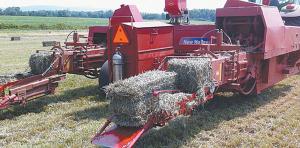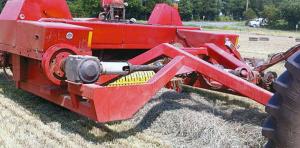2014 - Volume #38, Issue #3, Page #30
[ Sample Stories From This Issue | List of All Stories In This Issue | Print this story
| Read this issue]
Two New Holland Balers Merged Into One Big Machine
 |
 |
Inskeep’s double baler works efficiently because it picks up hay from large merged windrows, separates the inflow into two separate chambers, and kicks bales out two separate chutes in the back at the same time. One tractor pulls the oversize machine that Inskeep calls the “Mt. Pony Special”.
“I dreamed about building this double-barrel baler for two years, and then my nephew Paul and I spent the better part of two winters putting it together,” says Inskeep. “We’d been using a couple balers, and that always meant an extra tractor and an extra operator. I thought if we had a higher capacity outfit we could make our hay with less help and get it done just as fast, if not faster.”
Turns out the Mt. Pony Special is more than capable of high output. The Inskeeps averaged about 70,000 bales of hay and straw a year with it in 2012 and 2013. “One day we made just short of 5,000 bales in 6 hrs.,” Rusty says. “It was amazing to see.”
Inskeep’s double barrel special has the pickup, baling and discharge mechanisms of both New Holland 5070 machines. The machine on the left (looking back from the tractor) only has modifications to the hitch and the pickup. The other machine was cut apart and re-assembled to create a mirror image of the one on the left. A 7-1/2 ft. wide pickup is in the center of the joined machines, able to consume double-wide windrows. As hay is picked up, separate gathering forks pull material into both baling chambers. Plungers in each chamber cut, compact and build 50 to 60-lb. bales that are discharged out the back on separate chutes. Each chute is equipped with a moisture tester and scale so bales can be sized equally from both chambers. Uniform and equal weight bales are needed because the Inskeeps pick up all their hay with self-propelled bale wagons.
An elaborate, arching hitch made of 8 in. by 8 in. square tubing and reinforced framing behind the pickup holds the whole setup together. The conjoined machine is 13 ft. wide, weighs 11,000 lbs. and has a tongue weight of 2,640 lbs. It rides on two single 24-ply trailer tires. Rusty’s nephew Paul brought his computer programming and design skills to the project by configuring the whole setup on 3D CAD. “I only had ideas in my head and sketches on paper,” Rusty says. “Paul put it all onto the computer so we could make changes with the software rather than building it with metal and tearing it apart if it didn’t work.”
Configuring the drive for the two baling mechanisms was a major undertaking. A 1-3/8 in. dia.drive shaft runs from the 1,000 rpm tractor pto to a speed-reducing gearbox that creates two 540 rpm drives. The plungers are timed so they alternate compressing hay. “Because of the timed plungers, running this machine doesn’t take any more power than running one baler,” Inskeep says. They use a 140 hp. tractor with dual wheels to pull the baler. Twine is dispensed from a super-sized 16-ball twine box mounted between the two balers at the back.
The Inskeeps use the Mt. Pony Special for baling about 450 to 500 acres of hay and straw every year. Two discbines cut the hay, and twin rakes pull about 26 ft. of hay together into one super-sized swath for the baler. “It’s saved us a lot of time and helped speed up our operation,” says Rusty. “I think it probably does the work of 3 balers, and that’s just what we needed.”
Contact: FARM SHOW Followup, Rusty Inskeep, 22502 Mt. Pony Farms Drive, Culpeper, Va. 22701 (ph 540 825-0109).

Click here to download page story appeared in.

Click here to read entire issue




